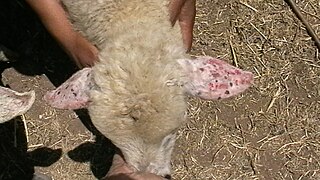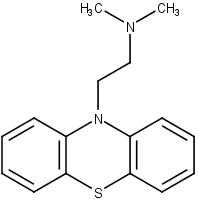
Phenothiazine, abbreviated PTZ, is an organic compound that has the formula S(C6H4)2NH and is related to the thiazine-class of heterocyclic compounds. Derivatives of phenothiazine are highly bioactive and have widespread use and rich history. The derivatives chlorpromazine and promethazine revolutionized the field of psychiatry and allergy treatment, respectively. An earlier derivative, methylene blue, was one of the first antimalarial drugs, and derivatives are under investigation as possible anti-infective drugs. Phenothiazine is a prototypical pharmaceutical lead structure in medicinal chemistry.

Chlorpromazine (CPZ), marketed under the trade names Thorazine and Largactil among others, is an antipsychotic medication. It is primarily used to treat psychotic disorders such as schizophrenia. Other uses include the treatment of bipolar disorder, attention deficit hyperactivity disorder, nausea and vomiting, anxiety before surgery, and hiccups that do not improve following other measures. It can be given by mouth, by injection into a muscle, or into a vein.

Fluphenazine, sold under the brand names Prolixin among others, is an antipsychotic medication. It is used in the treatment of chronic psychoses such as schizophrenia, and appears to be about equal in effectiveness to low-potency antipsychotics like chlorpromazine. It is given by mouth, injection into a muscle, or just under the skin. There is also a long acting injectable version that may last for up to four weeks. Fluphenazine decanoate, the depot injection form of fluphenazine, should not be used by people with severe depression.

Thioridazine is a piperidine typical antipsychotic drug belonging to the phenothiazine drug group and was previously widely used in the treatment of schizophrenia and psychosis. The branded product was withdrawn worldwide in 2005 because it caused severe cardiac arrhythmias. However, generic versions are still available in the US.

Promethazine is a first-generation antihistamine. It is used to treat allergies, trouble sleeping, and nausea. It may help with some symptoms associated with the common cold. It may also be used for sedating people who are agitated or anxious. It is available by mouth as a syrup, as a rectal suppository, or by injection into a muscle.

Acepromazine, acetopromazine, or acetylpromazine is a phenothiazine derivative antipsychotic drug. It was used in humans during the 1950s as an antipsychotic, but is now almost exclusively used on animals as a sedative and antiemetic. Its closely related analogue, chlorpromazine, is still used as an antipsychotic in humans. Acepromazine is used primarily as a chemical restraint in hyperactive or fractious animals.

Levomepromazine, also known as methotrimeprazine, is a phenothiazine neuroleptic drug. Brand names include Nozinan, Levoprome, Detenler, Hirnamin, Levotomin and Neurocil. It is a low-potency antipsychotic with strong analgesic, hypnotic and antiemetic properties that are primarily used in palliative care.
Ethylenediamine (abbreviated as en when a ligand) is the organic compound with the formula C2H4(NH2)2. This colorless liquid with an ammonia-like odor is a strongly basic amine. It is a widely used building block in chemical synthesis, with approximately 500,000 tonnes produced in 1998. Ethylenediamine readily reacts with moisture in humid air to produce a corrosive, toxic and irritating mist, to which even short exposures can cause serious damage to health (see safety). Ethylenediamine is the first member of the so-called polyethylene amines.

Photosensitivity is an abnormal skin reaction to direct sunlight exposure. It is unrelated to a sunburn. These reactions are due to photosensitization, the accumulation of photosensitive compounds beneath the skin. In some cases, the photodynamic substances come from ingested plants or drugs, after being metabolized or not. In other cases, the photodynamic substances may be produced in the body itself due to inborn errors in pigment metabolism, especially those involving the heme synthesis. Photosensitivity reactions are usually seen in herbivorous or omnivorous animals, though such reactions are not uncommon among carnivores.

Pralidoxime or 2-PAM, usually as the chloride or iodide salts, belongs to a family of compounds called oximes that bind to organophosphate-inactivated acetylcholinesterase. It is used to treat organophosphate poisoning in conjunction with atropine and diazepam. It is a white solid.

Thioxanthene is a chemical compound in which the oxygen atom in xanthene is replaced with a sulfur atom. It is also related to phenothiazine. Several of its derivatives are used as typical antipsychotics in the treatment of schizophrenia and other psychoses.

Aceprometazine (INN) is a phenothiazine derivative prescription drug with neuroleptic and anti-histamine properties. It is not widely prescribed. It may be used in combination with meprobamate for the treatment of sleep disorders. This combination is available in France under the trade name Mepronizine.

Triflupromazine (Vesprin) is an antipsychotic medication of the phenothiazine class. Among different effects of triflupromazine indication for use of this drug is severe emesis and severe Hiccups. Due to its potential side effects it is not gold standard in antiemetic therapy.

Acetophenazine (Tindal) is a typical antipsychotic of the phenothiazine class.

Tricyclics are chemical compounds that contain three interconnected rings of atoms.

Thiopropazate is a typical antipsychotic of the phenothiazine class. It is a prodrug to perphenazine.

Pipotiazine (Piportil), also known as pipothiazine, is a typical antipsychotic of the phenothiazine class used in the United Kingdom and other countries for the treatment of schizophrenia. Its properties are similar to those of chlorpromazine. A 2004 systematic review investigated its efficacy for people with schizophrenia:

Prothipendyl, also known as azaphenothiazine or phrenotropin, is an anxiolytic, antiemetic, and antihistamine of the azaphenothiazine group which is marketed in Europe and is used to treat anxiety and agitation in psychotic syndromes. It differs from promazine only by the replacement of one carbon atom with a nitrogen atom in the tricyclic ring system. Prothipendyl is said to not possess antipsychotic effects, and in accordance, appears to be a weaker dopamine receptor antagonist than other phenothiazines.

History of pharmacy can be dividend into two sub classes. i.e

Fenethazine (INN), or phenethazine, is a first-generation antihistamine of the phenothiazine group. Promethazine, and subsequently chlorpromazine, were derived from fenethazine. Fenethazine, in turn, was derived from phenbenzamine.



















